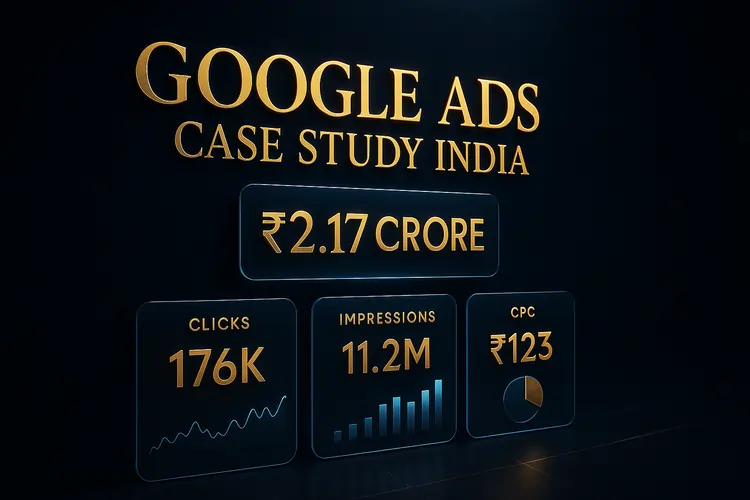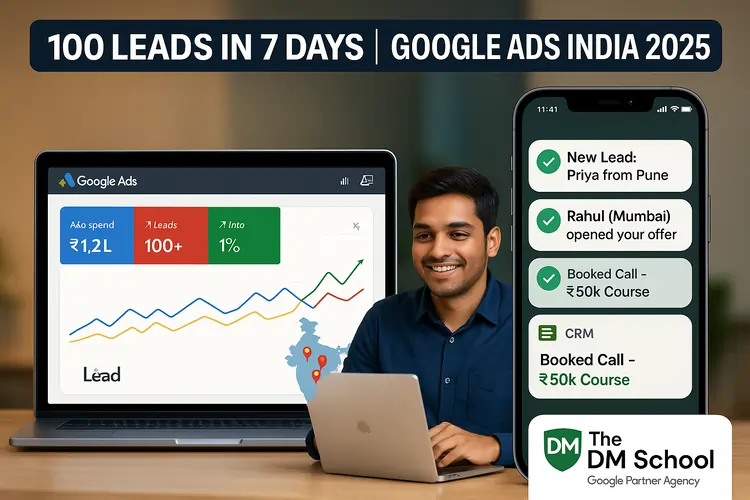Running Google Ads is easy. Turning them into a consistent profit machine is where most advertisers struggle. The difference between breaking even and scaling profits often comes down to how well you optimize each element of your campaign.
In this guide, you’ll learn how to optimize your Google Ads for better ROI using proven strategies, data-backed adjustments, and smart targeting. Whether you’re managing a small budget or scaling a high-spend account, these techniques will help you lower costs, increase conversions, and get maximum value from every click.
We’ll go beyond the basic tips most blogs repeat. You’ll discover how to identify wasted ad spend, use advanced targeting to reach high-intent buyers, and apply data insights to scale campaigns with confidence. By the end, you’ll know exactly what to tweak, when to tweak it, and how to measure the impact.
📌 Table of Contents
- Audit Your Existing Google Ads Campaigns
- Set Clear ROI-Focused Goals
- Refine Your Keyword Strategy
- Optimize Ad Copy for Click-Through & Conversions
- Improve Landing Page Experience
- Use Advanced Audience Targeting
- Choose the Right Bidding Strategy
- Track Conversions & Analyze Performance Data
- Scale Winning Campaigns
- Avoid Common Google Ads Mistakes
- FAQ on Google Ads Optimization
1. Audit Your Existing Google Ads Campaigns
Before you optimize for better ROI, you need to know exactly where your Google Ads campaigns are underperforming. An in-depth Google Ads audit reveals wasted spend, missed opportunities, and areas for immediate improvement.
Start by reviewing your campaign structure. Are your ad groups tightly themed around specific keywords? Are you separating search, display, and video campaigns? A messy structure makes optimization harder and reduces performance clarity.
🔍 Key Areas to Review in a Google Ads Audit:
- Campaign structure and naming conventions
- Search term reports for irrelevant keywords
- Ad copy performance by CTR and conversion rate
- Landing page relevance and conversion rate
- Device and location performance breakdown
- Budget allocation versus actual ROI per campaign
If you discover keywords that drive clicks but no conversions, consider pausing them or adding them as negative keywords. Likewise, identify high-performing segments — such as a specific location or device — and allocate more budget to them.
At The DM School, our audits combine Google Ads management expertise with Google Analytics insights to ensure every click is tied to measurable business outcomes. This approach helps cut wasted spend by up to 30% in the first month alone.
Quick Takeaway: A thorough audit is your roadmap. Without it, optimization is just guesswork — and guesswork is expensive.
2. Set Clear ROI-Focused Goals
Before you adjust bids, rewrite ads, or change targeting, you must define exactly what a successful campaign looks like. In Google Ads management, unclear goals often lead to scattered campaigns, wasted budget, and poor ROI.
Start by identifying the conversion actions that truly matter for your business — whether it’s purchases, lead form submissions, or booked calls. Avoid vanity metrics like impressions or clicks that don’t tie directly to revenue.
🎯 How to Define ROI Goals for Google Ads:
- Set a target ROAS (Return on Ad Spend) based on past performance
- Determine maximum acceptable CPA (Cost per Acquisition)
- Break down revenue goals by campaign and ad group
- Align ad objectives with sales funnel stages
- Set timelines for achieving each performance milestone
For example, if your average sale is ₹5,000 and your target ROAS is 4x, your campaign should generate at least ₹20,000 in revenue for every ₹5,000 spent. This calculation helps determine your bidding strategy and budget allocation.
At The DM School, we design campaigns starting with a clear ROI benchmark, then optimize creative, targeting, and bidding to hit those numbers consistently. This clarity ensures every click is an investment, not an expense.
Quick Takeaway: Define ROI before launching or optimizing your Google Ads — it’s the compass that keeps your campaigns profitable.
Refine Audience Targeting
Getting clicks is easy. Getting profitable clicks is where the game changes. In Google Ads, refining your audience targeting can be the difference between wasted spend and a campaign that delivers consistent ROI.
💡 Smart Targeting Tactics
- Use location targeting to focus on profitable regions and exclude low-performing areas.
- Adjust bids by device performance — mobile users may convert better in some industries.
- Leverage remarketing lists to re-engage high-intent visitors who didn’t convert the first time.
- Experiment with custom intent audiences for precise targeting based on search behavior.
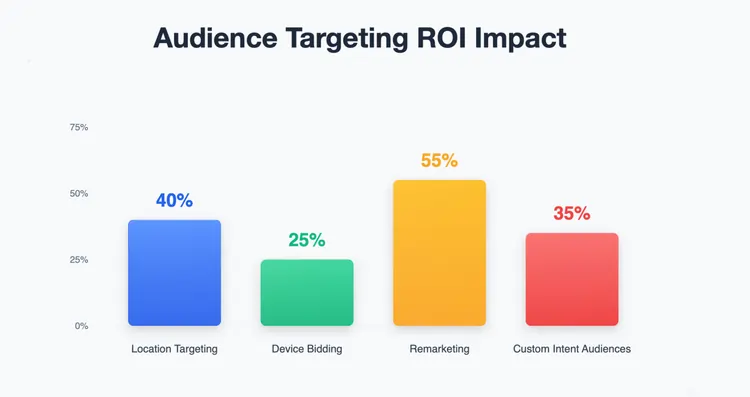
Audience Targeting ROI Impact: Location Targeting (+40%), Device Bidding (+25%), Remarketing (+55%), and Custom Intent Audiences (+35%) significantly improve Google Ads ROI when optimized correctly.
When you combine these tactics, you’re not just getting more clicks — you’re getting the right clicks. That means lower acquisition costs and higher profits.
Quick takeaway: Target smarter, not broader. The right audience beats a bigger audience every time.
4. Refine Your Keyword Strategy
If you want to master how to optimize your Google Ads for better ROI, start with tighter keyword control. Small tweaks here deliver big budget wins.
🎯 Three-Pillar Keyword Framework
- Intent: Prioritize high-intent terms (e.g. buy, price, near me).
- Match: Use exact/phrase for control; test broad with smart negatives.
- Pruning: Add negatives weekly to cut waste.
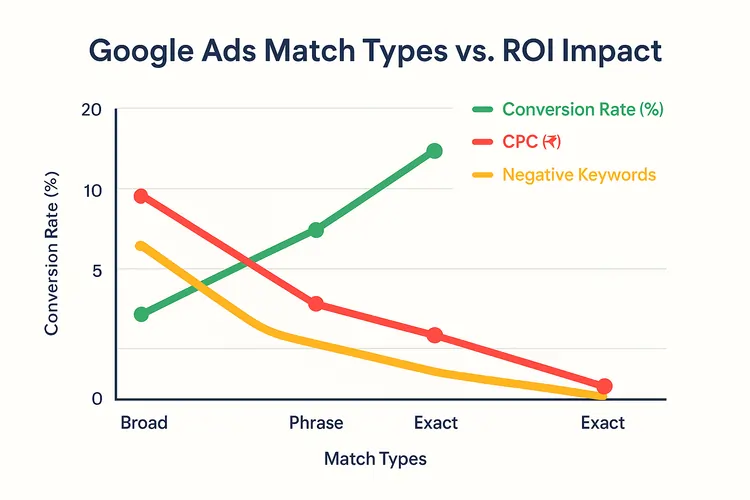
Keyword Match Type Impact: Exact match delivers highest conversion rate, phrase match balances reach and ROI, and smart use of negative keywords drives down CPC—unlocking better Google Ads ROI.
Build — Seed campaigns with phrase and exact match around your core offer. Expand thoughtfully with broad variants.
Guard — Regularly add negative keywords like “free,” “jobs,” or non-related terms to improve targeting.
Grow — Promote well-converting queries to exact match, then test broad + strict negatives for scaling reach.
India Example: “google ads agency delhi” (exact) delivers high intent leads at strong CPL. “digital marketing course free” (negative) blocks wasted clicks. Result: 28% lower CPA in two weeks.
🔥 Pro Tip: Split brand and non-brand keywords into separate campaigns. This protects brand CPCs and gives clear non-brand ROI visibility.
Learn how we structure search campaigns in our Google Search Ads service and the performance such structuring delivered in this Google Ads case study. Want help designing your funnel? Check out our digital marketing services or book a free strategy call.
Quick Takeaway: Control intent using match types, prune irrelevant terms, and promote winners to drive ROI with precision.
5. Optimize Ad Copy & Creative
Great targeting needs great messaging. Your ad must hook, prove, and direct. Small copy tweaks can create big ROI lifts.
🧩 The 3C Creative Formula
- Capture: Lead with the core benefit. Avoid vague claims.
- Convince: Add proof. Use data, awards, or case studies.
- Close: Use a clear CTA. Match page intent exactly.
Headlines: Promise a result. Add a time frame or qualifier.
Descriptions: Remove fluff. State value and next step.
Assets: Add sitelinks, callouts, and structured snippets.
🔥 Pro Tip: Separate brand and non-brand ad copy. Brand can be trust-first. Non-brand must be benefit-first.
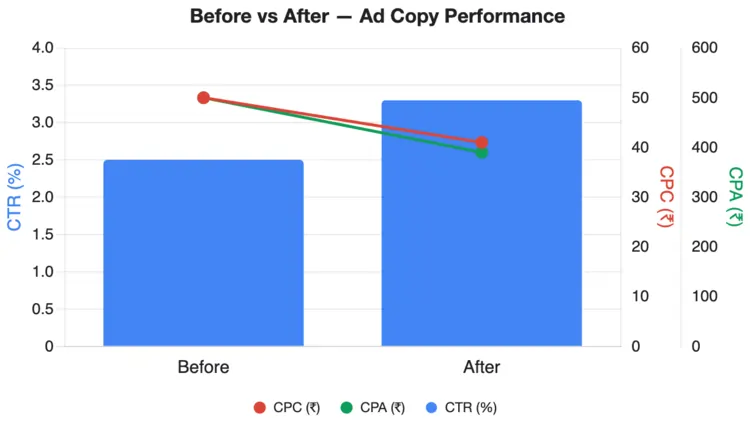
Before vs After: Revised headlines and assets increased CTR by 32%, reduced CPC by 18%, and cut CPA by 22% in two weeks.
India Example: “Get Google Ads Leads in 14 Days” beat “Grow with Google Ads.”
Pair with search ads best practices for faster wins.
✅ Visual Creative Checklist
- One promise per ad. No split focus.
- Numbers over adjectives. Use real data.
- CTA matches page intent. No friction words.
- Assets present. Sitelinks and callouts live.
- Ad strength high. Variations tested weekly.
See how tight copy plus assets drive results in our Google Ads case study.
Want a Google-approved setup? Review our Google Partner PPC approach or book a free strategy call.
Quick Takeaway: Promise clearly. Prove fast. Push one action. Then test weekly.
6. Improve Landing Page Experience
Great ads can’t save a weak landing page. Faster pages convert more. Clear pages convert best. Fix both to lift ROI fast.
⚡ Fast-to-Cash Checklist
- Load in < 3 seconds on 4G.
- One promise, one CTA, above the fold.
- Form fields ≤ 3 (name, email, phone).
- Trust stack: reviews, badges, case stats.
- Message match with ad headline.
- WhatsApp / click-to-call fallback CTA.
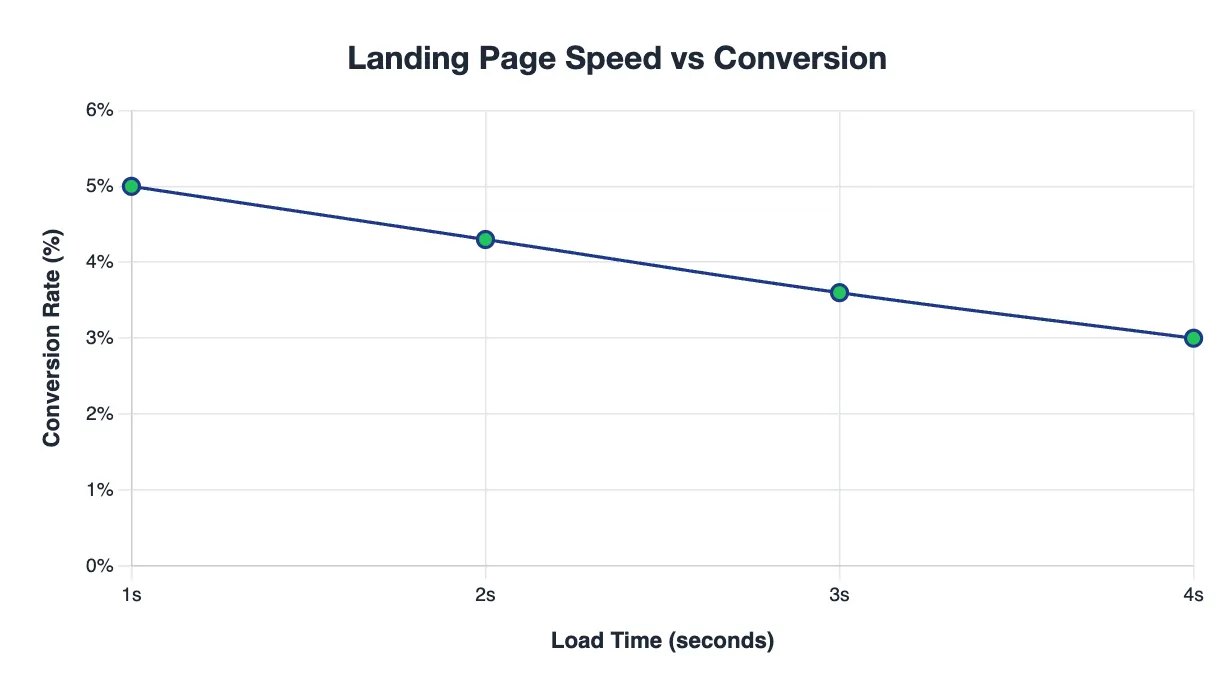
Speed vs Conversion: 1s ≈ 5.0% CVR, 2s ≈ 4.3%, 3s ≈ 3.6%, 4s ≈ 3.0%. Every extra second costs conversions (sample account averages).
Message Match: Mirror your ad promise in the H1 and first line. Keep the same keywords and benefit.
Form Friction: Ask only what sales needs. Add autofill and country code presets.
Trust Design: Place 3 bullets of proof + 1 logo row + 1 review snippet above the fold.
India Example: Reducing a webinar page from 5 fields to 3 lifted CVR by 22% and cut CPA by 19% in two weeks. Pair this with tight search intent in our
Google Search Ads service.
🔥 Pro Tip: Add a WhatsApp CTA on mobile. Many leads prefer a quick chat over a long form.
See real outcomes in our Google Ads case study.
Need a conversion-ready build? Explore our services or book a free strategy call.
Quick Takeaway: Make it fast, focused, and trustworthy. Then watch CPA fall.
7. Choose the Right Bidding Strategy
Bidding decides efficiency. Pick a model that matches data, goals, and cash flow. This is how to optimize your Google Ads for better ROI.
🎛️ Bidding Quick Guide
- Maximize Conversions — Use with low data. Good for start.
- Target CPA — Set a CPL/CPA goal. Needs steady conversions.
- Target ROAS — Scale revenue. Use when values vary.
- Maximize Clicks — Use for research only. Short-term.
- Manual CPC — Rare now. Keep for tight tests.
🧭 When to Use What
- New account: Start Max Conversions. Collect data fast.
- Lead gen with fixed value: Shift to tCPA. Guard CPL.
- Ecommerce or tiered LTV: Go tROAS. Protect margin.
- Exploration phase: Use Max Clicks. Cap bids hard.
- Control tests: Manual CPC in small ad sets.
🧪 Switch Rules
- Move to tCPA after 30–50 conversions in 30 days.
- Move to tROAS after 30+ value events with stable AOV.
- Change targets in small steps. 10–15% per week.
- Give each change 7–10 days to settle.
💰 Value-Based Bidding Essentials
- Send revenue with each conversion. Avoid flat values.
- Use offline imports for call or CRM deals.
- Enable enhanced conversions. Improve attribution accuracy.
- Weight high-LTV events more than form fills.
⚠️ Common Bidding Mistakes
- Targets too aggressive. Learning loops break.
- Frequent edits. Algorithm restarts often.
- No negatives. Broad eats budget fast.
- Mixing brand and non-brand. Data gets noisy.
Blend bidding with structure. Split brand and non-brand. Keep match types clean. Align bids to funnel goals from our
Search Ads service playbook and
Google Ads case study.
✅ Bidding Setup Checklist
- Right goal picked: tCPA or tROAS fits model.
- Enough data for smart bidding. Thresholds met.
- Targets modest. 10–15% changes only.
- Brand split from non-brand. Clean signals.
- Values passed with conversions. EC on.
Want a Google-approved approach? Review our Google Partner PPC framework and our full-funnel ad process.
Need help tuning targets? Book a free strategy call.
Quick Takeaway: Choose bids that fit your data today. Then scale targets slowly as proof grows.
Running your Google Ads is only half the battle. To truly maximize ROI, you must consistently monitor, analyze, and optimize based on live performance data. This step separates average campaigns from highly profitable ones.
📊 Track the Right Metrics
Avoid drowning in vanity metrics. Focus on KPIs that directly impact profitability: Conversion Rate (CVR), Cost per Conversion (CPA), Return on Ad Spend (ROAS), Click-Through Rate (CTR), and Impression Share. Use case study insights to benchmark.
🔄 Continuous A/B Testing
Always be testing. Rotate headlines, CTAs, ad formats, and landing pages. Track changes with labels inside Google Ads so you can measure the exact lift. Unlike random testing, structured tests give you statistically significant results faster.
📌 Use Automated Rules & Alerts
Set automated rules for pausing underperforming ads, increasing bids on high performers, and adjusting budgets by day of week. Pair this with Google Ads’ custom alerts so you never miss major shifts in cost or conversions.
🛠 Leverage Audience Insights
Regularly review your Audience tab to identify segments with the highest ROAS. Layer these audiences into your campaigns with bid adjustments for maximum efficiency.
Need expert help tracking and optimizing your campaigns? Our Google Ads specialists at The DM School use proven systems to turn ad spend into predictable profit.
Optimizing your Google Ads for better ROI is not a one-time task. It’s a continuous process of research, testing, and refinement. The difference between breaking even and achieving 5x returns often lies in the consistency and precision of your optimization efforts.
❓ Frequently Asked Questions
1. How often should I optimize my Google Ads?
For most campaigns, a weekly review is ideal. However, high-spend campaigns may require daily checks for bid adjustments, search term exclusions, and audience refinements.
2. What’s the fastest way to improve ROI?
Start with high-intent keywords, optimize your landing pages for conversions, and pause underperforming ads. Quick wins often come from fixing wasted ad spend.
3. Should I use automated bidding?
Automated bidding works well when you have sufficient conversion data. For new campaigns, manual CPC with enhanced bidding gives more control until you hit the data threshold.
4. How do I know if my ads are truly profitable?
Track ROAS (Return on Ad Spend) and CPA (Cost per Acquisition) against your target profit margins. If your ROAS is above your break-even point, you’re profitable.
5. Can I run Google Ads without a landing page?
Technically yes, but sending traffic to a dedicated landing page almost always improves conversion rates compared to sending visitors to a homepage or generic page.
